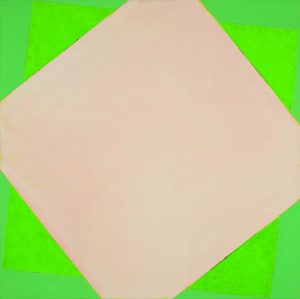
Zsigmond KÁROLYI
90 Degree Turn
- Year(s)
- 2006
- Technique
- oil on canvas
- Size
- 76x101 cm
Artist's introduction
Zsigmond Károlyi, after his figurative experiments of the 2000s – which manifested in archaizing, quasi-symbolic genre images, still lifes arranged from children's toys, sour pastiche pieces – once again started painting geometric images, returning to his concept from around 1977-78, which was based on the relationship of elementary forms and motion relations. His works recorded the triangle's and the rectangle's phases of rotation; his series of paintings is thus a synthesis of decades of artistic practice. The platform and the arguments of this pictorial summary are based on a kind of orthodoxy, on the fundamentalism of painting theory. At the same time, this becomes a stylistic framework, a characteristic form in itself. The visual structures created by rotation, the virtual shifting of planes, the division of the image surface and the transformation of this rhythm by adding new sections - sometimes planar fractals – provide a complex set of terms. Károlyi uses pure primary colours of additive and subtractive colour mixing in these procedures, complemented with the broken "mutants" of these colours. The almost exclusively square-format, balanced quality of the boards is juxtaposed with peculiar, immanent seriality, a gesture that generates form, folding out and across, folding in and down, mirroring. These processes vary and permute the planes intended and assumed to be regular, which are ultimately strikingly personal. The square is halved, the triangle is reflected. A circle or a sector appears only rarely. The forms are aligned in the austere tension of cold and warm, converging and receding hues and the delicate balance of complementary colours, while the images reveal something seemingly stricter, at the same time self-ironic, from a distance, but perhaps not involuntarily, indeed: a reference to Bauhaus, a quasi-pedagogical "dogmatism". István Hajdu
More artworks in the artist's collection »













